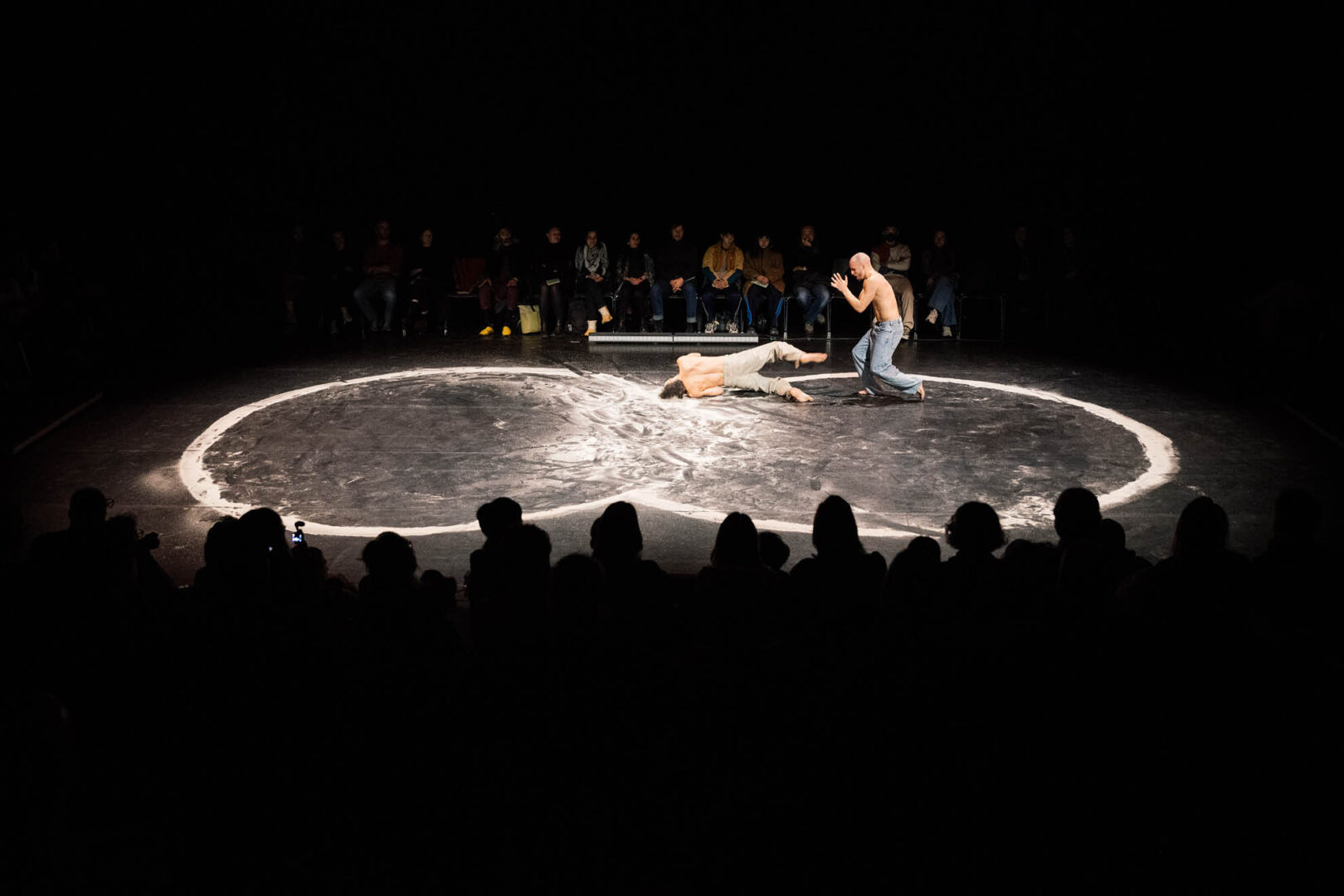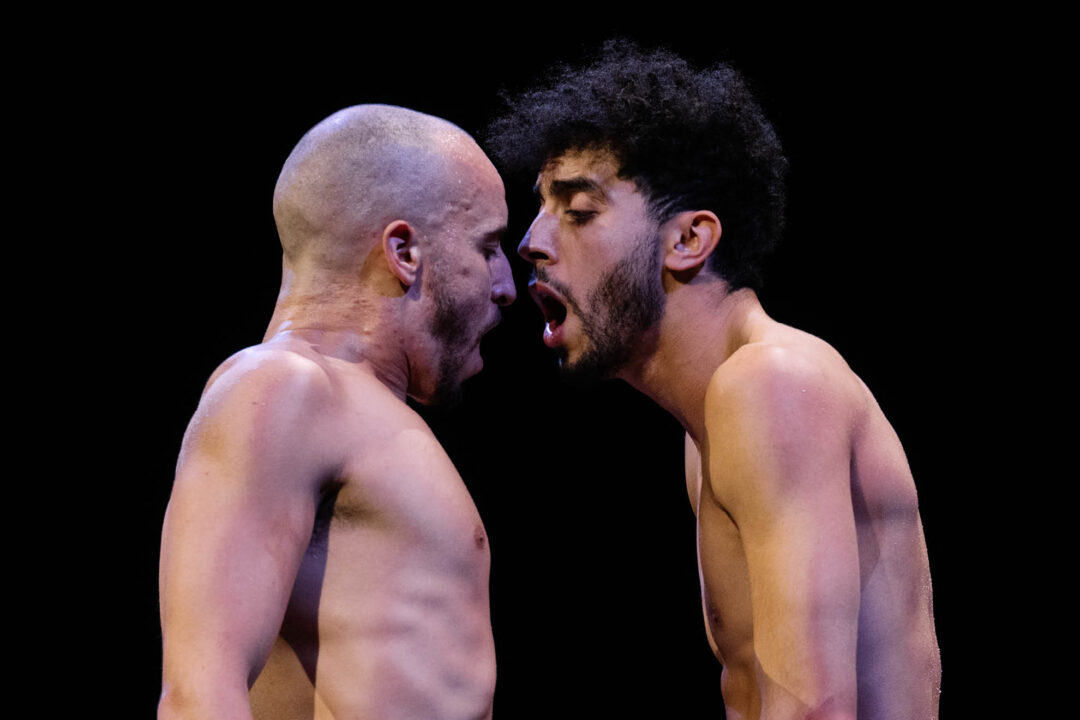Text: Gesine Borcherdt
Photos: Camille Blake

Text: Gesine Borcherdt
Photos: Camille Blake

Imagine a breathing sculpture. Its ribcage moving up and down, as if undulating, slowly and steadily. Almost imperceptible at first, it gradually starts taking more and more space, claiming more air, expanding into infinity. It is a meditative, circular gesture and you can almost imagine the whole world being one breathing, vibrating sculpture, where everything is connected.
Mehdi Dahkan’s sculpture is his body. For his performance series, KMs of resistance he moves and expands his body by doing what we all do, all the time, to stay alive: breathing. He focuses on the movements enabling the intake of air, and invites others to join in. Sharing his rhythm of inhalation and exhalation, his body becomes an “everybody”: a vast, moving organism taking space in, and out.
Dahkan was born in Tangier, Morocco, in 1998. In his childhood, it was hip-hop and breakdancing that sparked his interest in choreography. As Dahkan describes it, “self-learning but actually just doing” is what then led him to the rituals and gatherings in public spaces, which occur in the Maghreb specifically in conjunction with various resistance movements, and to the culture they all share across North Africa. By focusing on the body, Dahkan also looks at the ways in which communal movement often serves as a means to circumvent taboos in a society where codification—as a form of resistance—becomes an inventive response to restrictions. “This requires a certain awareness of how you present it and how you live in it,” he says.
How does the body work as a container of coded information, and how does this transform when the information is finally expressed? How do we use rhythm, movement, and feeling to create meaning? And how can the body become a symbol of political resistance? These questions form the basis of Dahkan’s choreographic work. “I liked the idea that with your own body, you can become and create something else,” he says, explaining that as a young boy, the Photos: Camille Blake gravity-defying movements of hip-hop dancers spinning on their heads seemed to him like a superpower. In KMs of Resistance, he seeks to invoke once again exactly that potential—by relating to the rituals and protests that his country has seen in the last hundred years.
The core of his trilogy, of which KMs of Resistance is the third and final part, is— in contrast to what comes to mind when one thinks of protests—silence. Dahkan describes a “physical silence, trying to protest as loud as I can without actually making any noise.” For him, the body is a symbol to play with, just as there are different ways to silently protest. “One way to do this is when you simply leave your country, so the absence of your body becomes an invisible imprint of resistance.”
Growing up in Tangier, the closest African city to Europe, the passage of people was an energy he felt every day. He calls it “existing in the moment,” which is also what conscious breathing means in meditation: embracing a precarious state of being, leaving the past behind, the future unclear.


Another form of passive protest that compelled Dahkan was people silently watching the sea, resisting activity. “There is a square in Tangier called Lazy Wall, where protests were not permitted. Now people go there and don’t do anything. There is just stillness. The city is full of life, but when you get there, it is as if somebody muted the space. It’s not an organized happening, people just started going there to sit in silence.” When the groups got bigger and bigger and blocked traffic became an issue, the authorities started asking questions. The answer would always be: “I’m just watching the sea.” And thus the still, silent body became a peaceful, powerful protest tool. But there is also resistance in the act of celebration.
For the piece he produced in the framework of Forecast, Dahkan honors the Chaabi dance gatherings that were used to share information about the resistance movement during Morocco’s struggle for independence. (Chaabi or Sha’bii means ‘folk’.) “Nobody would see them as more than entertainment. But during the period of French colonization, the musicians called for rebellion in their songs.” says Dahkan. Resistance was taking place as folkloric dance performances in front of the French soldiers’ eyes. They didn’t have a clue. Dahkan’s latest piece—which he first performed as a solo at the Forecast Forum and later developed for two dancers during his mentorship with Alice Ripoll—relates to the Chaabi dancers, but also to the traditional vocal Shikhat music of rural Morocco, called Aita.
“Aita in Arabic means cry out, lament, or scream, which describes perfectly the shrill tone of the Shikhats,” Dahkan explains. Here, too, the body became a tool with which to defy restrictions while avoiding censorship. “My piece takes this on by focusing on the breath. You can make noise and say a lot with it without speaking. You can create rhythm and show different feelings. The way you breathe can signify if you’re happy or upset.”
It’s certainly captivating to witness how Dahkan honors both his country’s celebratory art form and its creativity in finding ways to express resistance. By turning these stories into performative, minimalist sculptures, his work couldn’t feel more contemporary. Inviting others to breathe with him is a symbol for the interconnectedness of all beings in an almost Zen-like, non-dualistic way, where the individual self is overcome. In Dahkan’s case, this happens through shapes created by the act of breathing. “At a certain point, an entire room full of people starts breathing in the same way, which feels like a common ritual beyond any cultural tradition,” he says. “Everybody breathes in the same way, in every part of the world.”
You are currently viewing a placeholder content from Vimeo. To access the actual content, click the button below. Please note that doing so will share data with third-party providers.
More InformationYou are currently viewing a placeholder content from Facebook. To access the actual content, click the button below. Please note that doing so will share data with third-party providers.
More InformationYou need to load content from reCAPTCHA to submit the form. Please note that doing so will share data with third-party providers.
More InformationYou are currently viewing a placeholder content from Instagram. To access the actual content, click the button below. Please note that doing so will share data with third-party providers.
More InformationYou are currently viewing a placeholder content from Instagram. To access the actual content, click the button below. Please note that doing so will share data with third-party providers.
More InformationYou are currently viewing a placeholder content from X. To access the actual content, click the button below. Please note that doing so will share data with third-party providers.
More Information